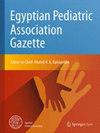Comparison of massage and prone position on heart rate and blood oxygen saturation level in preterm neonates hospitalized in neonatal intensive care units
IF 0.5
Q4 PEDIATRICS
引用次数: 0
Abstract
Many years ago, it was proposed that prone positioning and infant massage would benefit preterm and babies with low birth weight. Evaluating the effectiveness of massage therapy and the neonatal prone position on the heart rate (HR) and blood oxygen saturation level (SPO2) of premature neonates in neonatal intensive care units. Our study was conducted as a single-center, randomized controlled clinical trial at the NICUs of Menoufia University Hospital. After enrollment, the (240) cases were divided into group A: (80) infants with prone position, group B: (80) infants with massage therapy (as intervention groups), group C: (80) infants as a control group (without intervention). Regarding group A, there was a significant difference between the first and last days of intervention regarding HR and SPO2 at 15, 30, 45, and 60 min. Regarding group B, there was a significant difference between the first and last days of intervention regarding HR and SPO2 at 15, 30, 45, and 60 min. Regarding group C, there was no significant difference between the First and last days of intervention regarding HR at 15, 30, 45, and 60 min. Prone position and infant’s massage equally reduce Heart Rate and increase preterm babies' blood oxygen saturation level neonates admitted in NICU.在新生儿重症监护室住院的早产儿采用按摩和俯卧姿势对心率和血氧饱和度的影响比较
多年前,有人提出俯卧位和婴儿按摩对早产儿和出生体重不足的婴儿有益。评估按摩疗法和新生儿俯卧位对新生儿重症监护室早产儿心率(HR)和血氧饱和度(SPO2)的影响。我们的研究是在梅努菲亚大学医院新生儿重症监护室进行的单中心随机对照临床试验。入选后,240 个病例被分为 A 组:(80 个)采用俯卧位的婴儿;B 组:(80 个)采用按摩疗法的婴儿(作为干预组);C 组:(80 个)婴儿作为对照组(未进行干预)。就 A 组而言,在 15、30、45 和 60 分钟时,干预第一天和最后一天的心率和 SPO2 有显著差异。关于 B 组,在 15、30、45 和 60 分钟的心率和 SPO2 方面,干预的第一天和最后一天之间存在显著差异。至于 C 组,在 15、30、45 和 60 分钟的心率方面,干预第一天和最后一天之间没有明显差异。俯卧位和婴儿按摩同样能降低早产儿的心率,提高新生儿重症监护室新生儿的血氧饱和度。
本文章由计算机程序翻译,如有差异,请以英文原文为准。
求助全文
约1分钟内获得全文
求助全文
来源期刊

Egyptian Pediatric Association Gazette
PEDIATRICS-
自引率
0.00%
发文量
32
审稿时长
9 weeks
期刊介绍:
The Gazette is the official journal of the Egyptian Pediatric Association. The main purpose of the Gazette is to provide a place for the publication of high-quality papers documenting recent advances and new developments in both pediatrics and pediatric surgery in clinical and experimental settings. An equally important purpose of the Gazette is to publish local and regional issues related to children and child care. The Gazette welcomes original papers, review articles, case reports and short communications as well as short technical reports. Papers submitted to the Gazette are peer-reviewed by a large review board. The Gazette also offers CME quizzes, credits for which can be claimed from either the EPA website or the EPA headquarters. Fields of interest: all aspects of pediatrics, pediatric surgery, child health and child care. The Gazette complies with the Uniform Requirements for Manuscripts submitted to biomedical journals as recommended by the International Committee of Medical Journal Editors (ICMJE).
 求助内容:
求助内容: 应助结果提醒方式:
应助结果提醒方式:


